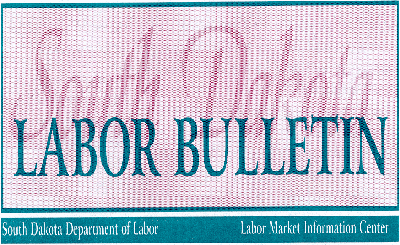
The following August 1999 article is South Dakota's research about various program graduates, whether they are employed and what their average wages are. It has been edited by Research & Planning's Carol Kjar, Administrative Assistant.

Follow that graduate
Most parents, relatives, education planners and policy makers are very interested in what happens to students after they graduate or complete a training program. To answer questions about programs, the South Dakota (SD) Department of Labor has implemented a program called the South Dakota Follow-Up Project. The project is administered by the Labor Market Information Center (LMIC) of the SD Department of Labor.
The Follow-Up Project is designed as a statistical research project and not to gather data for enforcement of laws and regulations. The reports provided to the participating educational institutions and agencies are tabulated by program. Information about individual graduates is not released. The LMIC is the caretaker of all the data collected and the confidentiality and privacy of these data are guarded very closely by agreements among all participants.
The basic methodology is to search for individuals on the wage records and payrolls for the U.S. Post Office, U.S. Department of Defense and the U.S. Office of Personnel Management. Colorado, Iowa, Kansas and North Dakota have agreed as well to provide employment data on South Dakota graduates and completers. In the near future, Nebraska, Montana and Wyoming are expected to start participating. One of the basic premises behind the Follow-Up Project is to look at placement results approximately one year after graduation, giving the graduate or completer time to find a job. Because of the one-year time lag, the latest placement data available is for 1997 graduates.
During the latest round of the Follow-Up Project, data were collected on 10,443 graduates. The total included graduates from corrections training programs (64), Adult Basic Education (ABE)/Graduate Equivalency Degree (GED) programs (1,464), Job Corps (134), Job Training Partnership Act (JTPA - 1,687), public universities (4,879), rehabilitation services and services to the blind and visually impaired (825) and technical institutes (1,390). The majority (51% or 5,372) of the graduates and completers were found on the SD wage record files as wage and salaried workers in SD businesses. The 5,372 graduates worked for 2,378 different employers, averaging about 2.3 graduates per employer.
Since self-employed graduates and completers do not show up on wage records and payrolls; other sources of data had to be consulted to find the self-employed. SD Department of Commerce and Regulation provided LMIC with driver's license and licensing/certification data. Those records indicated that 63.7 percent of the graduates and completers were still in the state, with technical institute graduates having the highest percentage of residents.
Using the various sources of information previously discussed, LMIC was able to account for about 79 percent of the graduates and completers, including some who had left the state. Many of them were in jobs with higher than average wages. As expected, the graduates with the most education were in the best paying jobs. The Table shows the average wages for graduates or completers in the different educational and training programs. Technical institute wages include diploma and associate programs.
This project will be beneficial to public agencies, universities, programs, states, job seekers, counselors, students, parents and employers in making decisions about programs. LMIC is working with the post-secondary institutions to determine which job placements are related to the educational program. The reports are also provided to the Governorís Office of Economic Development (GOED) and the State Occupational Information Coordinating Committee (SOICC). The GOED uses the data to make decisions about education and training programs relative to state economic development. The SOICC uses the data to improve the quality of career information for job seekers, students and others making decisions about career choices and programs.
Table of Contents | Labor Market Information | Employment Resources | Send Us Mail
These pages designed by Gayle C. Edlin.
Last modified on
by
Valerie A. Davis.